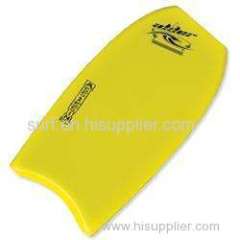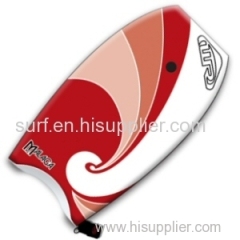|
Haiyi sports co.,LTD
|
slick board made in china
| Price: | 5.0~15.0 USD |
| Payment Terms: | T/T,L/C,WU |
| Place of Origin: | Zhejiang, China (Mainland) |
|
|
|
| Add to My Favorites | |
| HiSupplier Escrow |
Product Detail
high density eps foam, ixpe deck ,hdpe bottom, heat laminated construction
high density eps foam, xpe deck ,hard slick PP bottom ,glued construction
The Board: materials, construction, features[edit]
Materials
The bodyboard differs from a surfboard in the fact that it is much shorter (typically 97 to 109 cm (38 to 43 in) in length) and made out of different types of foam. The modern board consists of a foam 'core' encapsulated by a plastic bottom, a softer foam top known as the deck, softer foam sides known as the rails. The core is made of dow/polyethylene, arcel, or Polypro/polypropylene. The bottom is made of Surlyn or Bixby. The deck is made of 8LB or CrossLink. Each type of foam core, deck, or bottom material gives a bodyboard a different amount of flex and control. Speed from the bottom turn is increased when a bodyboarder bottom turns and the board flexes and recoils, releasing energy. If the board flexes too little or too easily, speed is lost. Dow (polyethylene) cores are best suited to cooler waters as they can be too flexible in warm water. Arcel and Polypro (polypropylene) cores are best suited for warmer waters due to their increased overall stiffness.
Most boards on the market today contain one, two, or three rods (usually of carbon or graphite), referred to as stringers, to strengthen the board, reduce deformation, add stiffness and recoil to the core, thus providing greater speed off bottom turns and transitions on the wave. If a single stringer is used, it is placed in the center of the board running parallel to the rails. If two are used, they are placed symmetrically about the y-axis. Triple stringers are a combination of the placement of both a single and double stringer.
Construction[edit]
Deck, rails, and bottom are bonded via various hot air lamination techniques to the core. Previous to the lamination technique, shapers accomplished this by using glue.
Features
The shape, or curve, of the board affects how it rides. If the wide point of the board is nearer to the nose, the board tends to be best suited to prone riding as the bodyboarder's weight rests further up on the board. Boards with more parallel rails or a narrow nose tend to be more ideal for drop-knee and stand-up riding as the rider's center of gravity tends to rest further back.
Most modern boards are equipped with channels that increase surface area in the critical parts of the board which, in turn, allow it to have varying hold and control on the wave. Originally, skegs were installed to decrease slippage on a wave face. However, progressive bodyboarding has rendered use of such skegs obsolete due to the looseness required for maneuverability on a wave. For such reasons, skegs are rarely used today and, even then, almost exclusively by dropknee or stand-up bodyboarders.
Tail shapes influence the way that boards perform in the line-up. Crescent tails provide the greatest amount of hold in steep waves. Crescent tails are generally preferred by drop-knee riders because the shape interferes less. Bat tails provide looseness for rail to rail transitions. Prone riders tend to prefer bat tails more than dropknee riders.











